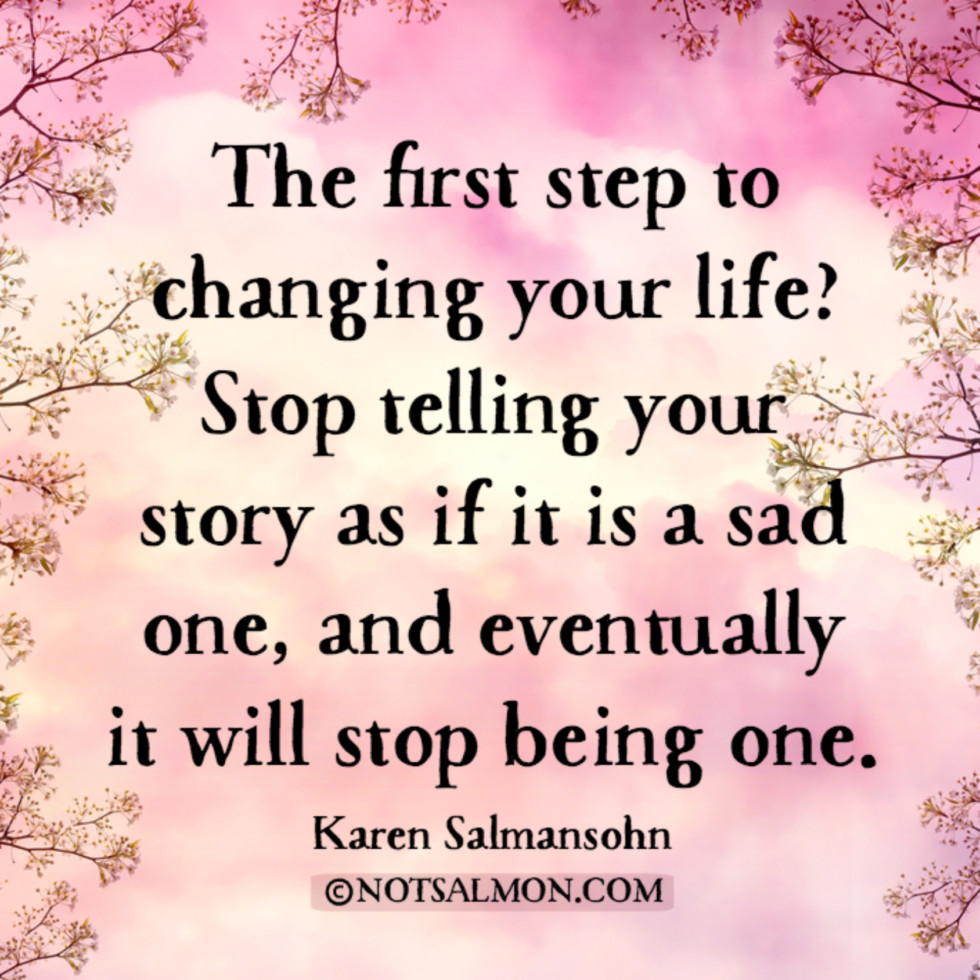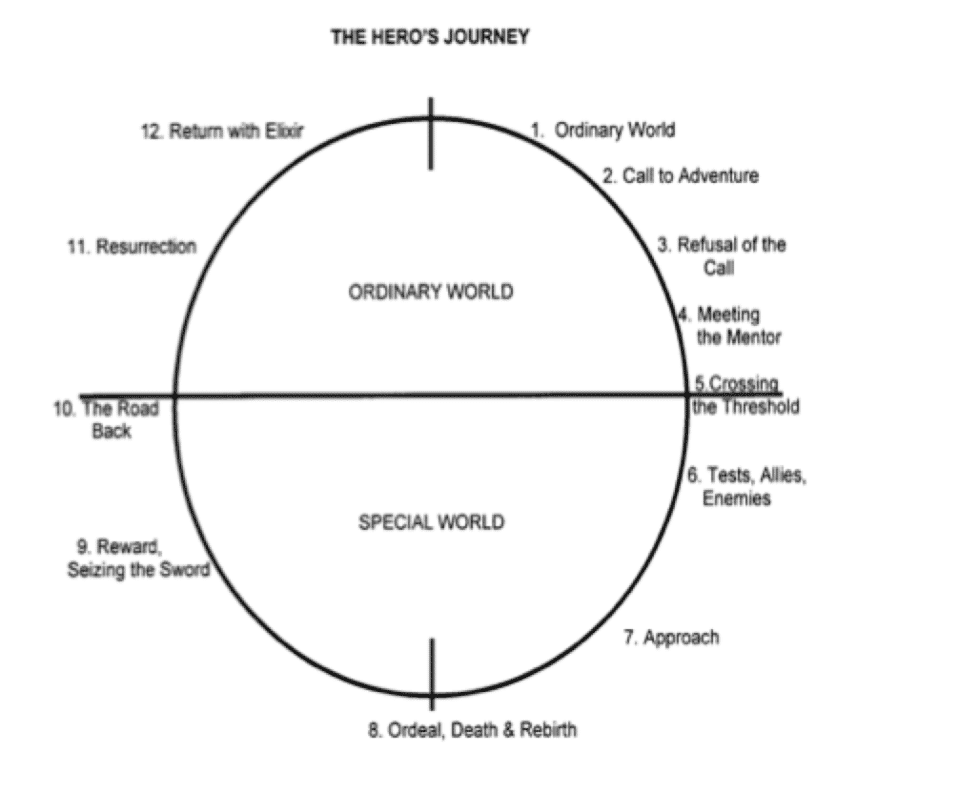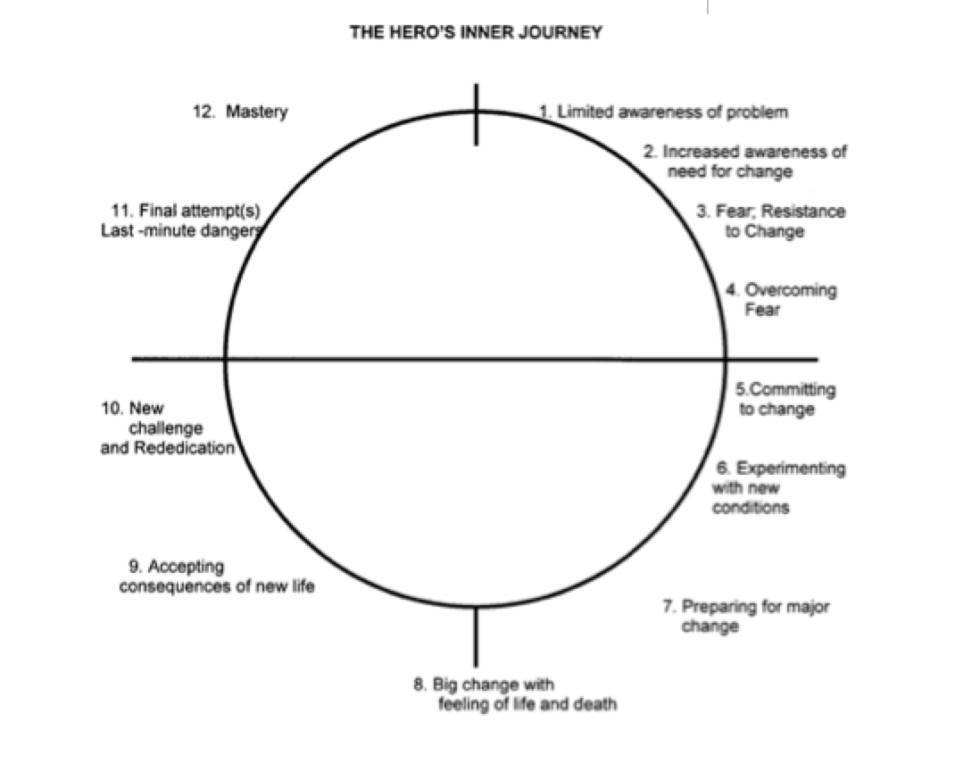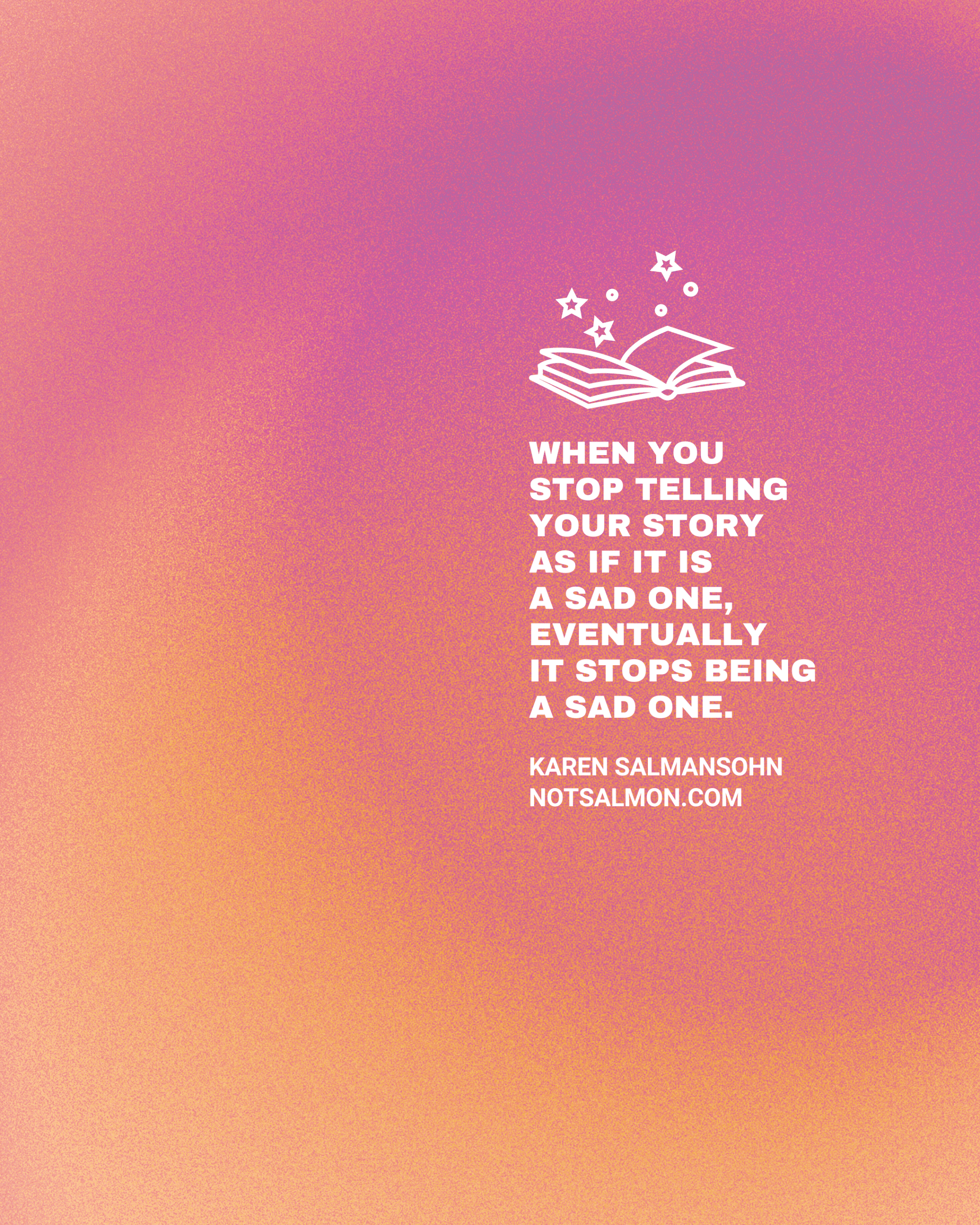 If you’re going through a challenging time, try memoir therapy, and start to write your way to a happier life. Here’s how I did it.
If you’re going through a challenging time, try memoir therapy, and start to write your way to a happier life. Here’s how I did it.
About a decade ago I met this guy who I thought was intoxicating. Turns out I was wrong by a few syllables. He was just plain ol’ toxic.
Let’s call him Tox to protect his identity.
Even though I knew Tox was a lethal combo of Trouble and Troubled, when we broke up I felt as if my Plan A Life had been pulled out from under me.
I wondered how it would ever be possible for a Plan B storyline to turn into a good thing.
So I healed myself by taking over the storyline. I decided to write a memoir about our challenging relationship. And I knew the ending of my life story in advance.
Spoiler Alert:
I knew my memoir needed to have a happy ending.
Of course I was writing the memoir at a time when I was still sad and alone – with no happy ending anywhere near sight.
Nonetheless I was determined to transform my sad little story into a hugely inspiring Lifetime Movie Of The Week kind of adventure.
My goal for my memoir story:
- Ultimately the lead character (me!) becomes stronger and happier thanks to all the challenges which she (me!) went through.
With this happy ending top of mind, I began writing my memoir about Tox and me.
So I started at the beginning – when we first met and fell in love. Next, I planted “red flags” in the storyline – the ones which I had noticed – but ignored. I laughed to myself as I wrote these chapters – wondering if the reader would be catching these “red flags” and yelling at the lead protagonist (me!) for ignoring them.
For this reason I began writing some of my backstory – to explain to the reader why and how I had ignored those red flags. I found writing my “back story” very therapeutic. My mood and spirit began to rise.
Another therapeutic benefit to writing my memoir…
I found I was waking up in the morning curious about what would happen to me in that given day – wondering what fateful events might lead me to the happy ending which I was insistent my storyline would include.
I’d bump into an old work colleague or meet a stranger at a coffee shop and wonder:
- Might this person become an important character in my memoir – someone who leads me to my happy ending?
Even “bad things” automatically showed up as “good things.”
I’d miss a train and wonder:
- Was I supposed to miss this train?
- Is this an important plot point in my memoir?
- Am I supposed to go on the next train – because I’m meant to meet someone special on the next train – someone who’s very important to my memoir’s storyline?
In fact, I discovered so many positive therapeutic benefits in writing my memoir that I began recommending “Memoir Therapy” to both friends and clients.
5 Tools for Memoir Therapy
Write your way to a happier life!
Psssst… I share more about this methodology in my Broken Heart Recovery Online Course.
1. One of the first things I wrote when I began my memoir therapy was my title.
I knew I needed a happy, inspiring title – because it was a must that my ending be a happy one. Below are a few titles I brainstormed up – which I invite you to nab for yourself.
The Assignment
I decided to think of Tox as an assignment for me to grow into my best self. With this title in mind, I began writing my story with the theme of how people come into our lives as our our teachers – how our tormentors can double-duty as our mentors. This title helped me to view everything which happened with a lens for learning – which was highly therapeutic.
The Gift
I decided to think of Tox as my “Gift Giver” – then look for the “gift.” I became curious and thought things like: “Ooh, there’s going to be a positive gift from all I went through. What’s going to be the gift?” I became what I call “a positive evidence collector” – instead of a negative evidence collector. I found myself looking for signs of positive outcomes. I’d follow leads to joy.
The Bridge
I chose to view my relationship with Tox as the portal I needed to go through to take me to a far better place. I began refocusing on the belief that sometimes people come into our lives to bring us to our next stage of life. People can be like “bridges” in that way. I began viewing Tox as my pathway to get me to my “main partner” – instead of thinking of Tox as my main partner. When I started to think of Tox as someone who might lead me to x, y or z, I found myself letting go of anger and shame.
2. I used Joseph Campbell’s “Hero’s Journey” as a guideline for my own life journey.
The inspiring Joseph Campbell wrote a lot about “The Hero’s Journey.” Many Hollywood movie scripts are actually purposefully written to follow Campbell’s description of a hero’s journey. Below are 2 charts which explains both the external events of a hero’s journey – as well as the inner transformation. Please check them out!


I love these 2 charts! I found them very beneficial to think about when I was writing my memoir. These 2 charts allowed me to view the challenges I went through as a “call to adventure” -meant to prepare me for huge beneficial change.
Thanks to these 2 charts I was able to see my life as as a Hero’s Journey – instead of a Loser’s Journey!
The big difference between a hero’s journey vs. a loser’s journey?
On a hero’s journey, a movie character grows by having “metaphorical rocks” thrown at them. The bigger “the rocks,” the bigger the growth opportunity.
On a true hero’s journey, the hero starts to focus on the growth from the rocks – and not just focus on that hailstorm of rocks.
A true hero views everything that happens as an opportunity to become stronger, happier and wiser.
A true hero turns pain into fuel – then into purpose!
If you’re presently depressed about a challenge you’ve gone through, it’s extremely therapeutic to start to think about how you can apply Campbell’s description of a hero’s journey to your life’s journey. Plus, it’s mega-therapeutic to write it all down in memoir form!
Speaking of… let’s get back to the world of memoir writing!
The first thing I want you to do is catalogue the “external events” of your hero’s journey.
Write down the plot points as they relate to the first chart Campbell created. Develop chapters around where/how/when you experienced a refusal of the call. Develop chapters around where/how/when you might have experienced a meeting of the mentor, a crossing of the threshold – plus tests, allies, enemies, reward – all that!
If you’re just beginning your memoir and you haven’t yet found your mentor – or your reward etc – start to keep your eyes open for their arrival! Wake up curious each day for when/how these experiences are going to show up in your life!
Next up, think about your inner journey.
Start by looking at that top right quarter of the circle – which is all about the hero experiencing a “limited awareness problem.” Make sure to weave into your opening chapters a range of paragraphs which recognize that your lead character (YOU!) has a limited awareness problem! As you continue to write your memoir, circle around Campbell’s circle chart – and be sure to include chapters which describe your lead character (YOU!) as developing an “increased awareness of a need for change” followed by “fear of resistance to change” – etc, etc, etc…
NOTE: Check out the second half of Campbell’s circle chart! He includes mention of more inner challenges – even as the hero grows. According to Campbell, even as the hero progresses, he/she is still scheduled to face “accepting consequences of the new life” – as well as “new challenges” – as well as “last minute dangers.”
With this in mind, don’t take it personally if you face new challenges on your journey of growth! Know that these new challenges are merely part of your hero’s journey – and happen to the biggest heroes!
3. Brainstorm up fun casting choices for the people in your memoir storyline!
I had fun thinking about which actors would play the role of Tox in the movie version of my memoir. Maybe Brad Pitt, Owen Wilson, Gerard Butler, Vince Vaughn, John Mayer? Humorously, all of these bad boys are Jennifer Aniston’s past love choices. But happily, Jennifer’s now found a good guy – so I’m guessing these men proved to be Jen’s Assignment, her Bridge, her Gift.
After I was done casting my romantic lead, I cast myself in my life story!
This was not only a fun exercise, it made writing my memoir easier because it jiggled my ego’s hold on my life story. I started to view my life from the outside looking in – saw myself as this “third person character” – which then allowed me to find some needed helpful laughter and a lot of healing insights.
Lastly, think up which actors and actresses you want to cast to play pretty much everybody in your memoir. You’ll quickly find that it’s very therapeutic and liberating to envision your life as a movie adventure – with lessons to teach.
4. Realize that the words “lead character,” “romantic character” (etc) each have the word “character” in them – because they’re all about “inner character.”
Next up, I want you to think about (and write about!) why your character was romantically attracted to the romantic character in your story- if your story is a love story.
If your story is not a love story, think about what your character needs to learn from other characters around her/him.
Next think about what the key “character traits” are within your lead character (YOU!) which she/he needs to develop. Ditto write about the key “character traits” represented in all the other characters in your memoir.
View all the events in your life journey as….
- a test of your lead character’s “inner character”
- a reveal of other people’s “true character.”
Be sure to spend some time writing about the various “character traits” which you as your lead character need to develop – as well as the “character traits” that other characters in your story either have going for them – or against them.
Get excited for your lead character (YOU!) to grow your inner character – thanks to being surrounded by….
- bad characters (with bad character traits) – who challenge YOU and thereby help you to grow
- good characters (with good character traits) – who support YOU and thereby help you to grow
5. Constantly play around with writing new endings to your memoir therapy story
When I was writing my memoir, I kept playing around with the ending – even before it happened! I’d playfully write about me happily involved with various wonderful man – who were chock full of specific good character traits.
Admittedly I was writing the pages of my “happy ending” prematurely! I had no idea how the storyline was going to unfold to get me to this place of love, happiness and inner peace. But writing about a happy ending – even before it happened – kept me feeling curious instead of furious.
I’d walk around each day wondering:
- “What’s going to happen today to take me where I want to go?”
I found myself thinking happy thoughts like:
- “Ooh, I can’t wait to see how my happy life story’s going to unfold.”
Know this now:
When you feel confident that a happily-ever-after awaits you, then you wind up acting more confidently. And this confidence helps you to do the actions of a hero – which then leads you more swiftly to your hero’s happy ending!
Remember:
The pain inside your mind is not a reality. It’s just one singular story you’ve chosen to tell yourself. We live in a world of a million interpretations. You must resist being stuck on just one interpretation. Especially when you choose the most negative interpretation. When you write an inspiring memoir, you become far more open to seeking out a wide range of interpretations – including many happy, enlightened and optimistic interpretations.
Memoir Therapy Summary
 When you choose to explore memoir therapy, you quickly become a better story teller of your life. You become more adept at viewing your struggle as a beautiful growth opportunity – a true hero’s journey!
When you choose to explore memoir therapy, you quickly become a better story teller of your life. You become more adept at viewing your struggle as a beautiful growth opportunity – a true hero’s journey!
Note: Even if you do not actually write a memoir… make it a practice to start telling your story with a new spin – with a bit less sorrow and a lot more sass.
Instead of replaying that mental montage of mishaps, highlight the times where you figure things out.
Find the moments that made you smarter, stronger, and loaded with that gritty, spit-in-the-face-of-adversity kind of wisdom.
It’s not about denying the downs, but maybe giving more airtime to the ups.
Because let’s be honest, even in the crappiest of chapters, there were those moments when you were more kick-ass than kicked-down.
Start narrating your story from that angle, and just like that, your story will transform from a tale of woe into a tale of wow.
Get More Support To Write Your Way To A Happier Life
Join my groundbreaking online course: Broken Heart Recovery
Think happier. Think calmer.
Think about subscribing for free weekly tools here.
No SPAM, ever! Read the Privacy Policy for more information.
One last step!
Please go to your inbox and click the confirmation link we just emailed you so you can start to get your free weekly NotSalmon Happiness Tools! Plus, you’ll immediately receive a chunklette of Karen’s bestselling Bounce Back Book!


 If you’re going through a challenging time, try memoir therapy, and start to write your way to a happier life. Here’s how I did it.
If you’re going through a challenging time, try memoir therapy, and start to write your way to a happier life. Here’s how I did it.

 When you choose to explore memoir therapy, you quickly become a better story teller of your life. You become more adept at viewing your struggle as a beautiful growth opportunity – a true hero’s journey!
When you choose to explore memoir therapy, you quickly become a better story teller of your life. You become more adept at viewing your struggle as a beautiful growth opportunity – a true hero’s journey!